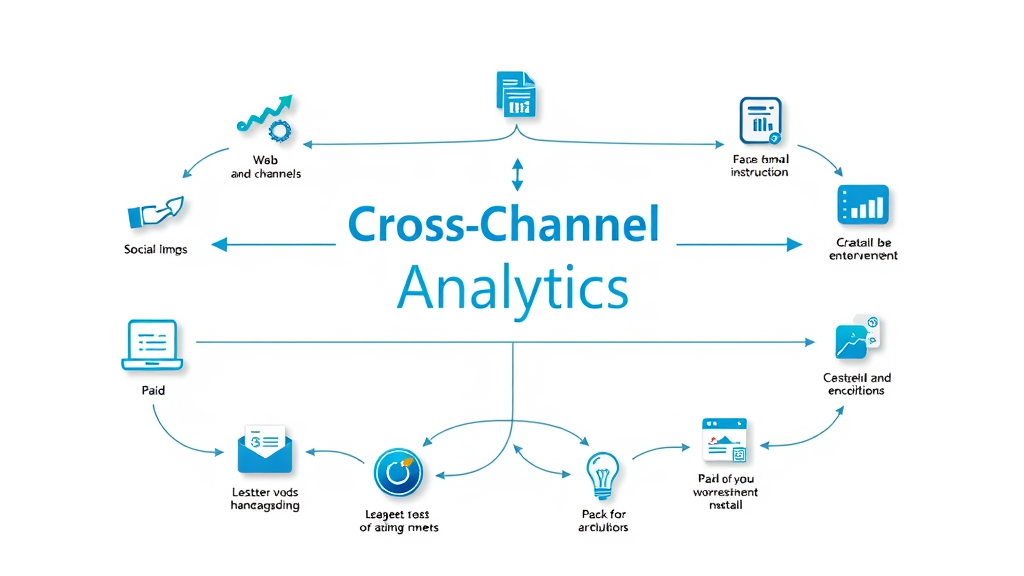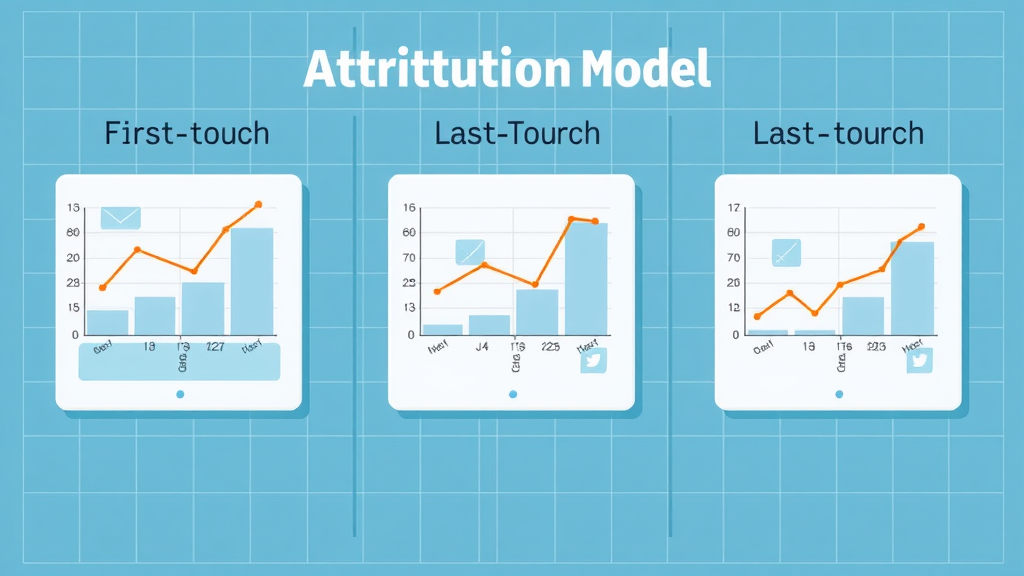Did you know that 76% of marketers still struggle to effectively use cross-channel analytics for business growth? Yet, 61% of marketers, according to WhatsApp, believe that the most critical part of a successful cross-channel strategy is accurate measurement and analysis of the metrics. In a world where customers jump seamlessly from social media to web, email, and beyond, having a unified view of analytics data isn’t just an advantage—it’s a necessity. Cross-channel analytics is transforming how marketing teams uncover valuable insights, optimize spend, and improve the customer journey. Dive in to discover why this approach is becoming the linchpin of smarter channel marketing and decision-making.
Unlocking Smarter Decision-Making with Cross-Channel Analytics: Why 76% of Marketers Still Struggle
As marketing landscapes become more fragmented, the ability to track and unify analytics data across diverse marketing channels is more vital than ever. Despite this consensus, a staggering proportion of marketers are still caught in silos—relying on isolated data sources from social media, web traffic, email marketing, and even mobile app engagement. This lack of cohesion leads to missed opportunities, poorly allocated budgets, and inconsistent customer experiences.
One core challenge is the growing complexity of channel marketing strategies. Customers interact with brands on multiple devices, switching between networks and platforms without a second thought. Without robust cross-channel analytics in place, marketing teams are left with blind spots in their understanding of the customer journey—not to mention limited ability to optimize channel attribution and improve return on investment. This section will reveal the foundational pitfalls many marketers encounter, and why mastering cross-channel analytics is the first step toward achieving truly data-driven results.

Challenging the Norm: The Impact of Cross-Channel Analytics on Channel Marketing
Cross-channel analytics doesn’t just unify data—it flips traditional channel marketing on its head. Instead of treating each marketing channel as a standalone effort, cross-channel solutions aggregate analytics data across social media, email, web, and mobile apps. This comprehensive view empowers marketing teams to identify overlapping touchpoints, spot underperforming channels, and allocate resources with confidence. What’s more, channel attribution becomes smarter and more nuanced: marketers can finally see which interactions matter most in a customer’s journey, leading to better overall returns from their marketing efforts.
Many organizations find that deploying an effective analytics tool is transformative for campaign optimization. Not only does it provide granular insight into customer behavior and channel analytics, but it also enables seamless collaboration between teams managing multiple data sources. The ripple effect? Measurable boosts in ROI, higher engagement across marketing channels, and a new culture of agile, insight-led decision-making for channel marketing teams.
What You'll Gain By Mastering Cross-Channel Analytics
The fundamentals and advanced aspects of cross-channel analytics
How to integrate systems to unify analytics data
Leveraging channel analytics for business growth
Optimizing channel marketing with smarter attribution models
Infusing marketing analytics into every customer journey
Understanding Cross-Channel Analytics for Channel Marketing
To succeed at channel marketing today, you must understand the difference between isolated channel analytics and the holistic approach of cross-channel analytics. Traditional channel analytics focus on data from one marketing channel at a time—be it social media, email, or web. While helpful, this method leaves out parts of the customer journey and makes accurate channel attribution challenging. In contrast, cross-channel analytics unifies all analytics data, forming a comprehensive view of how customers interact with each touchpoint throughout their journey.
With unified analytics data, businesses are no longer limited by fragmented insights. Marketers can track a customer’s path from the first ad click to the final purchase—across multiple devices and platforms. This means that each piece of analytics data paints a more complete and actionable picture, supporting more effective channel marketing strategies and driving smarter business decisions.
Defining Cross-Channel Analytics and Channel Analytics
Cross-channel analytics is the practice of aggregating, integrating, and analyzing marketing analytics across all available channels. While channel analytics gives you insights on how each individual channel is performing, cross-channel analytics brings everything together under a single analytical lens. For example, a marketing team might use channel analytics to assess the performance of a Facebook ad campaign but turn to cross-channel analytics to see how that campaign drives actions on the website, engagement on the mobile app, and conversions from follow-up email sequences.
This combined approach not only breaks down data silos but also unlocks more powerful attribution models. By connecting the dots between customer interactions, it becomes possible to understand how marketing efforts across different channels contribute to overall business goals. This is at the heart of unified channel marketing—and it’s changing the way marketers view, interpret, and act on customer and analytics data.
Key Elements: Analytics Data and Channel Attribution
The foundation of effective cross-channel analytics lies in two core pillars: high-quality analytics data and precise channel attribution. Collecting comprehensive data across all platforms—including social media, email, web, and mobile—ensures that marketers have the information they need to make data-driven decisions. Clean, consistent analytics data is critical to accurately mapping out the customer journey and recognizing meaningful patterns.
Channel attribution further enhances the value of unified analytics by helping businesses assign appropriate credit to each customer touchpoint. Rather than defaulting to first- or last-touch attribution models, an insightful analytics platform might use advanced multi-touch attribution to reflect the full breadth of the customer’s experience. This enables a more nuanced understanding of what’s working in the marketing channel mix and where improvements are necessary for optimizing channel marketing strategies.

How Cross-Channel Analytics Drives Effective Channel Marketing
Cross-channel analytics transforms traditional channel marketing by providing a panoramic view of the customer journey. Instead of focusing solely on individual campaigns or touchpoints, marketers gain insight into the complete arc of customer interactions—across every marketing channel and network. This empowers organizations to build cohesive campaigns that maximize impact, eliminate redundant spending, and streamline marketing efforts.
For example, tracking analytics data across the customer’s journey reveals which touchpoints drive the highest engagement or conversions. Marketers can then fine-tune channel attribution and allocate spend to the most effective marketing channels. By integrating advanced analytics tools, marketing teams create feedback loops that continuously improve performance and drive long-term growth.
Channel Marketing vs. Multichannel and Omnichannel Approaches
While “multichannel” and “omnichannel” strategies both involve the use of several marketing channels, they differ significantly from cross-channel analytics. Multichannel focuses on maintaining a presence across multiple platforms but may lack the unified, analytics-driven approach required to understand customer journeys in context. Omnichannel attempts to create seamless experiences, but without effective channel analytics, businesses may still miss critical attribution touchpoints.
Channel marketing anchored by cross-channel analytics stands apart by integrating and analyzing analytics data from all platforms at once. This strategy moves beyond basic interaction tracking and delivers the insights needed to optimize each channel’s contribution to the company’s overall goals. By leveraging advanced attribution models, marketers identify and reinforce the most influential touchpoints across the entire marketing channel ecosystem.
Harnessing Analytics Platforms and Analytics Tools
Choosing the right analytics platform is vital to unlocking the full power of cross-channel analytics. Modern platforms seamlessly connect with varied data sources, including social, search, web, and mobile apps, allowing marketing teams to construct a complete and real-time view of customer interactions. The best analytics tools offer dashboards that are not only visually intuitive but also customizable, making the extraction of actionable insights straightforward for marketers at all levels.
When organizations invest in analytics platforms that automate data collection, integration, and reporting, they free up valuable time and resources for more strategic activities. Not only can they identify gaps in their channel marketing efforts, but they can also experiment rapidly, iterate based on performance, and maintain agility in dynamic market conditions. These advantages make analytics tools essential to any smart, future-focused marketing analytics strategy.

Deep Dive: Customer Journey Analytics in Cross-Channel Analytics
At the intersection of cross-channel analytics and marketing analytics is customer journey analytics—a powerful lens for understanding and shaping how customers move from awareness to conversion. This process involves analyzing all touchpoints, interactions, and experiences, regardless of marketing channel, and gives marketers the clarity they need to optimize every stage of the customer journey.
With robust journey analytics in place, marketing teams can detect obstacles, drop-off points, and high-impact opportunities across the entire customer experience. This holistic view strengthens your ability to personalize communication, identify what content drives results, and build loyalty by nurturing deep, meaningful relationships through targeted channel marketing strategies.
The Role of Customer Journey Analytic and Customer Journey Analytics in Modern Channel Analytics
Customer journey analytic tools track the myriad ways customers interact with brands—from the initial exposure through social media or search engines, to subsequent engagements via email campaigns, mobile apps, and web experiences. These analytics tools map the customer experience with painstaking detail, offering both high-level trends and granular, actionable analytics data that fuel business growth.
In the context of channel analytics, journey analytics provides actionable insights about cross-channel movement. Instead of viewing each marketing channel in a vacuum, journey analytic connects and contextualizes all interactions. This deep understanding enables businesses to create campaigns tailored to the real behaviors of their customers, sharpening channel marketing effectiveness and ultimately increasing ROI.
Tracking Cross Channel Experiences to Improve Customer Experience
Tracking cross channel experiences is crucial for companies aiming to provide exceptional customer journeys. By examining analytics data from multiple data sources, marketers can detect where customers switch between marketing channels and how these touchpoints shape their perceptions. This bird’s-eye view of customer behavior is essential for optimizing both the overall customer experience and each channel’s specific role within it.
Effective use of journey analytics ensures that marketing teams provide consistent, useful, and personalized experiences at every step. When cross-channel analytics uncovers pain points or underperforming touchpoints, marketers can respond swiftly, making adjustments that positively affect customer satisfaction and drive engagement. Ultimately, customer journey analytics lays the foundation for marketing analytics strategies rooted in real results—not just broad assumptions.

Decoding Attribution Models in Cross-Channel Analytics
One of the most critical aspects of cross-channel analytics is channel attribution—accurately determining which marketing channels and touchpoints deserve credit for driving customer actions. Attribution models are mathematical frameworks that assign value to each point in the customer journey, shaping everything from marketing budgets to messaging priorities. With so many ways to approach attribution, understanding the nuances of different models is vital for effective channel marketing.
Cross-channel analytics empowers organizations to compare attribution models and find the best method for their objectives. By leveraging data-driven attribution, marketers not only improve the accuracy of performance measurement but also unlock new efficiencies by optimizing spend where it matters most.
Exploring Channel Attribution and Attribution Models for Accurate Measurement
Channel attribution involves tracking every interaction a customer has with your marketing content and assigning value based on those interactions. First-touch and last-touch attribution models offer basic insights by giving all the credit to the first or last customer interaction, respectively. However, these models don’t fully reflect the complexities of modern customer journeys across multiple marketing channels.
Multi-touch attribution models go further, assigning value to multiple points along the journey—such as the initial ad click, a subsequent email engagement, and the final purchase. By analyzing analytics data from all relevant marketing channels, multi-touch models give a more accurate picture of what’s driving conversions. This granularity ensures marketers aren’t over- or under-investing in critical channel marketing efforts.
Comparing Attribution Model Best Practices for Channel Analytics
When it comes to choosing the right attribution model for your business, best practices dictate that marketers regularly evaluate, test, and refine their approach. Advanced analytics platforms make it easy to compare models head-to-head, measuring which delivers the most accurate and actionable insights given your customer data and behavior.
Ultimately, the best attribution model is one that accounts for the full complexity of modern channel marketing—capturing every relevant touchpoint across all marketing channels. Businesses should also use these models to continually optimize their marketing analytics strategies, iterating as customer behaviors, channels, and technologies evolve.
Comparison of Popular Attribution Models and Their Impact on Channel Marketing Results |
|||
Attribution Model |
Approach |
Pros |
Cons |
|---|---|---|---|
First-Touch |
Assigns all credit to the first interaction |
Simple, easy to implement |
Ignores later touchpoints, risk of oversimplification |
Last-Touch |
Gives all credit to final conversion touchpoint |
Focuses on closing actions |
Misses influence of earlier channels |
Multi-Touch |
Distributes credit across multiple interactions |
Comprehensive, reflects journey complexity |
Requires more data and analysis, can be complex |

Building a Unified Analytics Platform for Seamless Cross-Channel Analytics
A single, unified analytics platform is the backbone of any successful cross-channel analytics initiative. Rather than piecing together scattered data sources, businesses that invest in integrated systems achieve smoother workflows, more reliable analytics data, and deeper insights into channel marketing performance. Modern analytics platforms harness data science and automation, turning thousands of data points from every marketing channel into actionable strategies.
Integration is key: By uniting all data sources and analytics tools, organizations build an experience platform that connects every marketing channel—resulting in smarter, faster decisions that drive measurable growth.
Key Features of an Effective Analytics Platform
The best analytics platforms share several essential features: robust data integration capabilities, easy-to-use dashboards, customizable reporting, and robust data governance. These platforms should connect to all major data sources—social networks, ad tech tools, web trackers, CRM databases, and more. Automation for cleaning and normalizing analytics data is critical to ensure consistency and reliability in every report.
Additionally, a good analytics platform offers advanced attribution models, real-time performance monitoring, and the flexibility to adapt as new marketing channels emerge. This combination ensures that marketing teams can continually optimize their channel marketing strategies without the risk of being left behind by technological change.
Integrating Analytics Data Across Different Marketing Channels
The process of integrating analytics data typically starts with establishing connectors between all primary data sources—from social media and web analytics to mobile apps and CRM systems. The analytics platform pulls in customer data, normalizes it for consistency, and prepares it for deep-dives into marketing analytics and channel analytics.
As integration matures, marketers can view customer journeys in real-time across all platforms, identifying cross-channel effects that might otherwise remain hidden. This integrated approach offers a singular, actionable view of each customer and every campaign, empowering smart, unified channel marketing.

Channel Analytics Best Practices: Making Smarter Decisions with Cross-Channel Analytics
To maximize the impact of cross-channel analytics, marketing teams need well-defined best practices for both channel analytics and analytics data. This begins with identifying and tracking critical KPIs, leveraging real-time analytics tools, and continually refining attribution models. By combining data discipline with strategic use of analytics platforms, organizations ensure every decision is data-driven and every marketing channel is fully optimized.
The best practices outlined below offer a structured path to smarter channel marketing decisions, greater visibility into customer journeys, and sustained improvements in ROI.
Critical KPIs and Metrics in Marketing Analytics
Conversion Rate
Cost Per Acquisition (CPA)
Customer Lifetime Value (CLV)
Click-Through Rate (CTR) per channel
Attribution Conversion Paths
Multi-touch Contribution Scores
Engagement Metrics (sessions, dwell time, bounce rate)
Optimizing Marketing Channels Using Cross-Channel Analytics Data
-
List: Top 7 Marketing Channel Metrics to Monitor
Channel-Specific ROI
Conversion Attribution by Channel
Cost Per Lead by Source
Engagement Rates (likes, shares, comments, etc.)
Churn Rate by Channel
Customer Satisfaction or NPS per Channel
Funnel Drop-Off Points
-
List: 5 Proven Strategies for Better Channel Attribution
Leverage multi-touch attribution models
Validate attribution findings with real conversion data
Integrate all data sources into one analytics platform
Continuously test and adapt attribution models
Use analytics tools to visualize complex channel journeys
Case Studies: How Leading Brands Excel with Cross-Channel Analytics
Many forward-thinking brands are already seeing impressive results by adopting robust cross-channel analytics. For example, a major retail brand used integrated analytics data to optimize its channel marketing mix, identifying overlooked touchpoints and shifting investments accordingly. Within months, the brand saw measurable increases in conversion rates, customer engagement, and ROI across all marketing channels.
These brands illustrate the real potential of channel analytics when paired with intelligent attribution models and a culture committed to data-driven decisions. Their success stories serve as a blueprint for marketing teams looking to unify their analytics efforts and deliver superior results.
"With cross-channel analytics in place, we optimized our channel marketing mix and increased ROI by more than 40%." – Digital Marketing Director, Retail Brand

People Also Ask: Key Questions About Cross-Channel Analytics
What is cross-channel analytics?
Comprehensive Answer: Cross-channel analytics involves gathering, unifying, and analyzing data from multiple marketing channels to gain actionable insights. This process helps organizations optimize their marketing analytics, track customer journeys, and make more informed decisions across different channel marketing efforts.
What is cross network in analytics?
Insightful Answer: Cross network in analytics refers to evaluating performance and results across varied digital networks and platforms. The approach aligns closely with cross-channel analytics and ensures marketing analytics strategies consider the full breadth of available analytics data.
What is an example of a cross-channel?
Example Response: An example of cross-channel is integrating email marketing with social media campaigns and web analytics. Using cross-channel analytics, marketers can connect the data to see how customers move from one channel to another throughout their journey.
What do you mean by channel analytics?
Thorough Explanation: Channel analytics is the process of tracking, measuring, and analyzing the performance of individual marketing channels. In the cross-channel analytics context, channel analytics provides the building blocks for constructing a holistic understanding of marketing performance.
A visually engaging explainer video that demonstrates data flowing across multiple marketing channels, highlights real-time insights gained from cross-channel analytics, and uses animated graphics, customer journey visuals, and before-and-after marketing ROI comparisons.
Follow along as we walk through the essential steps marketers need to build a unified analytics platform, from connecting all your data sources to setting up custom dashboards and optimizing reporting for smarter channel marketing decisions.
See how brands of all sizes deploy different attribution models within an analytics platform, comparing the outcomes of first-touch, last-touch, and multi-touch strategies—and the impact on marketing channel ROI.
Discover actionable ways to pinpoint, analyze, and enhance every customer interaction across your marketing channels using state-of-the-art analytics tools. Learn how to personalize the customer journey and drive higher engagement.
FAQs About Cross-Channel Analytics, Channel Marketing, and Channel Analytics
How does cross-channel analytics differ from traditional marketing analytics?
Cross-channel analytics aggregates and analyzes data from all channels to provide a unified view of customer journeys and campaign effectiveness, while traditional marketing analytics often focuses on siloed, individual channels in isolation.
Why is channel attribution important in multi-channel marketing strategies?
Channel attribution helps assign the right value to each marketing touchpoint, allowing marketers to understand which channels influence conversions, allocate budgets wisely, and improve overall marketing strategy.
What’s the best analytics platform for cross-channel analytics?
The best analytics platform integrates all your data sources, offers advanced attribution models, enables easy reporting, and provides real-time insights. Popular solutions include Google Analytics 4, Adobe Analytics, and Oracle Marketing Cloud.
How can I improve my customer experience using journey analytics?
Use journey analytics to track and visualize the customer’s path across channels, identify pain points, and create targeted improvements. This leads to seamless experiences and increases satisfaction at every touchpoint.
What core analytics data should every marketer track for smarter decisions?
Core analytics data includes channel-specific ROI, conversion rates, cost per acquisition, customer lifetime value, engagement metrics, and attribution paths—enabling well-grounded marketing decisions.
Takeaways for Marketing Analytics and Cross-Channel Analytics Success
Cross-channel analytics unlocks smarter decision-making by breaking down data silos.
Effective channel attribution ensures marketing spend is optimized.
The right analytics platform brings together all channel marketing efforts under one view.
Customer journey analytic and journey analytics highlight touchpoints that need improvement.
Continuous analysis and optimization are vital for long-term channel analytics impact.
Ready to Maximize the Power of Cross-Channel Analytics?
Take your marketing analytics and channel marketing strategy to the next level with advanced cross-channel analytics—start today by evaluating your current analytics platform and analytics data.

Take action: Review your analytics platform, connect all your marketing channels, and unlock the data-driven edge your brand deserves!
Sources
Adobe Analytics Attribution – https://www.adobe.com/analytics/attribution.html
HubSpot Marketing Analytics Resources – https://www.hubspot.com/
To deepen your understanding of cross-channel analytics and its impact on marketing strategies, consider exploring the following resources:
Is your Marketing Just Limping Along? Would you like your strategies to Work Together Seamlessly and Effectively? Click this link to Download the “The Ultimate Small Business Cross-Channel Marketing Checklist”
“How to Implement Cross-Channel Analytics: A Guide for Marketers” ( matomo.org )
This guide offers a comprehensive overview of cross-channel analytics, detailing the benefits of integrating data from various marketing channels and providing a step-by-step approach to implementation.
“Benefits Of Cross-Channel Analytics For Search Marketers” ( searchengineland.com )
This article discusses the advantages of cross-channel analytics, including improved understanding of customer behavior and enhanced marketing performance.
By delving into these resources, you’ll gain valuable insights into effectively implementing cross-channel analytics to optimize your marketing efforts.
 Add Row
Add Row  Add
Add 




Write A Comment